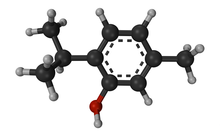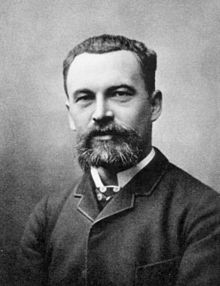티몰
Thymol
 | |
 | |
| 이름 | |
|---|---|
| 우선 IUPAC 이름 5-메틸-2-(프로판-2-일)페놀[1] | |
| 시스템 IUPAC 이름 5-메틸-2-(프로판-2-일)벤제놀 | |
| 기타 이름 2-이소프로필-5-메틸페놀, 이소프로필-m-크레솔, 1-메틸-3-히드록시-4-이소프로필벤젠, 3-메틸-6-이소프로필페놀, 5-메틸-2-이소프로필-1-페놀, 5-2-메틸페놀, 5-2-메틸 | |
| 식별자 | |
3D 모델(JSmol) | |
| 체비 | |
| 첸블 | |
| 켐스파이더 | |
| 드러그뱅크 | |
| ECHA 정보 카드 | 100.001.768 |
| EC 번호 |
|
| 케그 | |
PubChem CID | |
| 유니 | |
CompTox 대시보드 (EPA ) | |
| |
| |
| 특성. | |
| C10H14O | |
| 몰 질량 | 150.221 g/g−1/g |
| 밀도 | 0.96 g/cm3 |
| 녹는점 | 49 ~ 51 °C (120 ~124 °F, 322 ~324 K) |
| 비등점 | 232 °C (450 °F, 505 K) |
| 0.9g/L(20°[2]C) | |
굴절률(nD) | 1.1408[3] |
| 약리학 | |
| QP53AX22 (WHO) | |
| 위험 요소 | |
| GHS 라벨링: | |
   | |
| 경고 | |
| H302, H314, H411 | |
| P260, , , , , , , , , , , , , , | |
달리 명시되지 않은 한 표준 상태(25°C[77°F], 100kPa)의 재료에 대한 데이터가 제공됩니다. | |
티몰(일명 2-이소프로필-5-메틸페놀, IPMP), CHO는1014 p-Cymene의 천연 모노텔페놀 유도체로 카르바크롤과 이성질체이며, 타임유에서 발견되며, Tymus gulris(일반적인 타임), ajwain [4]및 다양한 식물에서 향기로운 냄새와 강한 방부제 성질의 백색 결정성 물질로 추출된다.티몰은 또한 T. vullis에서 생산되는 요리 허브인 티몰의 독특하고 강한 맛을 제공합니다.티몰은 중성 pH에서 물에 약간만 녹지만 알코올 및 기타 유기 용제에 매우 잘 녹습니다.페놀의 탈양성자로 인해 강알칼리성 수용액에도 용해된다.해리 상수(pKa)는 10.59±0.[5]10이다.티몰은 274 [6]nm에서 최대 자외선을 흡수합니다.
화학 합성
티몰은 m-크레졸과 프로펜의 [7][8]알킬화에 의해 생성된다.
- CHHOH364 + CHCH23 → (CH3)2CHOH363
역사
고대 이집트인들은 방부 [9]처리를 위해 타임을 사용했다.고대 그리스인들은 그것이 용기의 원천이라고 믿으며 그것을 목욕탕에 사용하고 신전에서 향으로 태웠다.타임이 유럽 전역에 퍼진 것은 로마인들이 방을 정화하고 "치즈와 [10]리큐어에 향기로운 맛을 주기 위해" 사용했기 때문이라고 생각되었다.유럽 중세에, 이 약초는 잠을 자고 악몽을 [11]쫓기 위해 베개 아래에 놓였습니다.이 기간 동안, 여성들은 종종 기사들과 전사들에게 백일해 잎을 포함한 선물을 주었는데, 그것이 운반자에게 용기를 준다고 믿었기 때문이다.백향은 또한 향으로 사용되었고 장례식에서 관에 놓이게 되었는데, 그 이유는 백향은 다음 [12]생으로 가는 것을 확실히 하기 위해서였다.
북미산 야생화인 벌방모나르다 피스툴로사와 모나르다 디디마는 티몰의 천연 공급원이다.블랙풋 원주민들은 이 식물들의 강한 방부작용을 인식하고 피부 감염과 가벼운 상처에 이 식물들의 낙지를 사용했습니다.그것들로 만들어진 티산은 또한 충치와 치은염으로 [13]인한 입과 목의 감염을 치료하는데 사용되었다.
티몰은 1719년 [14]독일의 화학자 카스파르 노이만에 의해 처음 분리되었다.1853년, 프랑스의 화학자 알렉상드르 랄망은 티몰이라는 이름을 붙이고 그것의 경험식을 [15]결정했어요.티몰은 [16]1882년 스웨덴의 화학자 오스카 위드만에 의해 처음 합성되었다.
조사.
시험관내 연구에 따르면 티몰과 카르바크롤은 살모넬라 티푸스 SGI 1과 스트렙토코커스 피오제네스 [17]ermB와 같은 동물성 병원균과 식품 부패 박테리아에 대한 여러 항생제의 최소 억제 농도를 낮추는 데 매우 효과적이었다.시험관내 연구에 따르면 티몰은 음식 부패와 소 [18]유방염에 대한 항진균제로 유용하다.Tymol은 대장균과 P. aeruginosa(그램 음성) 및 황색포도상구균과 B. cereus(그램 양성)[19] 검사주에 대해 시험관내 항균 후 효과를 나타낸다.이러한 항균 활동은 성장과 젖산 생산을 억제하고 세포 포도당 [20]흡수를 감소시킴으로써 발생합니다.
타임 에센셜 오일은 식품 보존에 유용하다.타임 에센셜 오일의 주요 부분인 티몰의 항균 특성은 부분적으로 친유성 특성과 관련이 있으며, 이는 박테리아 막에 축적되고 [21]에너지 고갈과 같은 후속 막과 관련된 사건으로 이어집니다.
식물에 병원성이 있는 일부 균류에 대한 티몰의 항진균 성질은 균사 형태를 바꾸고 균사체를 발생시켜 균사벽의 [22]균사 지름과 용액을 감소시키는 능력 때문이다.
사용하다
1910년대 동안 티몰은 [23][24]미국에서 구충 감염에 대한 선택적인 치료제였다.중동 사람들은 내부 [25]기생충을 줄이고 제거하기 위해 다량의 백일해로 만든 진미인 자타르를 계속 사용하고 있다.할로탄 방부제, 마취제, 구강세정제 방부제로도 사용됩니다.플라크와 치은염을 줄이기 위해 사용될 때,[26] 티몰은 순수하게 단독으로 사용될 때보다 클로르헥시딘과 함께 사용될 때 더 효과적인 것으로 밝혀졌다.티몰은 또한 존슨앤드존슨의 유티몰과 같은 일부 치약의 활성 방부 성분입니다.티몰은 바로아 진드기를 성공적으로 제어하고 벌 [27]군락에서 발효와 곰팡이의 성장을 방지하는 데 사용되어 왔다.티몰은 또한 빠르게 분해되고 지속되지 [18][28]않는 농약으로도 사용됩니다.티몰은 의료용 소독제 [29]및 범용 소독제로도 사용할 수 있습니다.
티몰 함유 식물 목록
- 일리시움베룸
- 유프라시아 로스트코비아나[30]
- 라고에치아 쿠미노이데스[31]
- 모나르다디디마[32]
- 모나다누룩사[33]
- 모슬라치넨시스 샹루(香 ()
- 오리가눔 콤팩텀[34]
- 오리거넘 딕탐누스[35]
- 오리가눔오나이트류[36][37]
- 오리가눔 벌가레[38][39]
- 사테자 심브라
- 흉선[34]
- 흉선모충[40]
- 흉선박쥐[40][41]
- 흉선지기스[42]
- 쯔카미
독성학 및 환경에 미치는 영향
2009년 미국 환경보호청(EPA)은 티몰의 독성학과 환경에 미치는 영향에 대한 연구 문헌을 검토한 결과, "티몰은 잠재적 독성을 최소화하고 위험을 최소화한다"[43]는 결론을 내렸다.
환경파괴 및 농약으로 사용
학문은 환경에선 특히 탄화 수소 monoterpenes과 thymol이 저하 빠르게(DT50 물에 16일, soil[28]에 5일)고 보여 준 것이기 때문에, 빠른 손실과 낮은 바운드 residues,[28]thymol은 다른 더 지속적인 화학까지 안전한 대안을 제공한다 농약이 계약 선수로 사용을 지원하는 때문에 낮은 위험. 살충제유출로 분산되어 후속 오염을 발생시킬 수 있습니다.
보충 상태
「 」를 참조해 주세요.
주 및 참고 자료
- ^ "Front Matter". Nomenclature of Organic Chemistry : IUPAC Recommendations and Preferred Names 2013 (Blue Book). Cambridge: The Royal Society of Chemistry. 2014. p. 691. doi:10.1039/9781849733069-FP001. ISBN 978-0-85404-182-4.
- ^ "Thymol". PubChem. Retrieved 1 April 2016.
- ^ Mndzhoyan, A. L. (1940). "Thymol from Thymus kotschyanus". Sbornik Trudov Armyanskogo Filial. Akad. Nauk. 1940: 25–28.
- ^ O'Connell, John (27 August 2019). The book of spice : from anise to zedoary. New York: Pegasus. ISBN 978-1681774459. OCLC 959875923.
- ^ CAS 레지스트리: SciFinder에서[full citation needed] 취득한 데이터
- ^ Norwitz, G.; Nataro, N.; Keliher, P. N. (1986). "Study of the Steam Distillation of Phenolic Compounds Using Ultraviolent Spectrometry". Anal. Chem. 58 (639–640): 641. doi:10.1021/ac00294a034.
- ^ Stroh, R.; Sydel, R.; Hahn, W. (1963). Foerst, Wilhelm (ed.). Newer Methods of Preparative Organic Chemistry, Volume 2 (1st ed.). New York: Academic Press. p. 344. ISBN 9780323150422.
- ^ Fiege, Helmut; Voges, Heinz-Werner; Hamamoto, Toshikazu; Umemura, Sumio; Iwata, Tadao; Miki, Hisaya; Fujita, Yasuhiro; Buysch, Hans-Josef; Garbe (2000). "Phenol Derivatives". Ullmann's Encyclopedia of Industrial Chemistry. Weinheim: Wiley-VCH. doi:10.1002/14356007.a19_313.
- ^ "A Brief History of Thyme - Hungry History". HISTORY.com. Archived from the original on 13 June 2016. Retrieved 9 June 2016.
- ^ Grieve, Mrs. Maud. "Thyme. A Modern Herbal". botanical.com (Hypertext version of the 1931 ed.). Archived from the original on 23 February 2011. Retrieved 9 February 2008.
- ^ Huxley, A., ed. (1992)새로운 RHS 정원 가꾸기 사전.맥밀런.
- ^ "Thyme (thymus)". englishplants.co.uk. The English Cottage Garden Nursery. Archived from the original on 27 September 2006.
- ^ Tilford, Gregory L. (1997). Edible and Medicinal Plants of the West. Missoula, MT: Mountain Press Publishing. ISBN 978-0-87842-359-0.
- ^ Neuman, Carolo (1724). "De Camphora". Philosophical Transactions of the Royal Society of London. 33 (389): 321–332. doi:10.1098/rstl.1724.0061. 324페이지에서 노이만은 1719년에 다양한 허브에서 에센셜 오일을 추출했다고 언급합니다.326페이지에서, 그는 이러한 실험들 동안, 그가 "캄포라 티미"라고 부르는 티미 기름으로부터 결정 물질을 얻었다고 언급합니다.(노이만은 오늘날 장뇌라고 불리는 특정 물질뿐만 아니라 어떤 식물의 휘발성, 향기로운 기름에서 침전된 결정성 물질에 "장뇌"라는 이름을 붙였습니다.)
- ^ Lallemand, A. (1853). "Sur la composition de l'huile essentielle de thym" [On the composition of the essential oil of thyme]. Comptes Rendus (in French). 37: 498–500.
- ^ Widmann, Oskar (1882). "Ueber eine Synthese von Thymol aus Cuminol" [On a synthesis of thymol from cuminol]. Berichte der Deutschen Chemischen Gesellschaft zu Berlin (in German). 15: 166–172. doi:10.1002/cber.18820150139.
- ^ 를 클릭합니다Palaniappan, Kavitha; Holley, Richard A. (2010). "Use of natural antimicrobials to increase antibiotic susceptibility of drug resistant bacteria". International Journal of Food Microbiology. 140 (2–3): 164–168. doi:10.1016/j.ijfoodmicro.2010.04.001. PMID 20457472..
- ^ a b Nieto, G (2017). "Biological Activities of Three Essential Oils of the Lamiaceae Family". Medicines. 4 (3): 63. doi:10.3390/medicines4030063. PMC 5622398. PMID 28930277.
- ^ Zarrini, G; Bahari-Delgosha, Z.; Mollazadeh-Moghaddam, K; Shahverdi, A. R. (2010). "Post-antibacterial effect of thymol". Pharmaceutical Biology. 48 (6): 633–636. doi:10.3109/13880200903229098. PMID 20645735. S2CID 39240936.
- ^ Evans, J.; Martin, J. D. (2000). "Effects of thymol on ruminal microorganisms". Curr. Microbiol. 41 (5): 336–340. doi:10.1007/s002840010145. PMID 11014870. S2CID 24460829.
- ^ Nychas G.J.E. In: 식물의 천연 항균제.Gould G.W., 편집자Blackie Academic Professional; 영국 런던: 1995. 페이지 58-59.새로운 식품 보존 방법.
- ^ Numpaque, M. A.; Oviedo, L. A.; Gil, J. H.; García, C. M.; Durango, D. L. (2011). "Thymol and carvacrol: biotransformation and antifungal activity against the plant pathogenic fungi Colletotrichum acutatum and Botryodiplodia theobromae". Trop. Plant Pathol. 36: 3–13. doi:10.1590/S1982-56762011000100001.
- ^ Ferrell, John Atkinson (1914). The Rural School and Hookworm Disease. US Bureau of Education Bulletin. Vol. No. 20, Whole No. 593. Washington, DC: U.S. Government Printing Office.
- ^ Milton, Joseph Rosenau (1913). Preventive Medicine and Hygiene. D. Appleton. p. 119.
- ^ Inskeep, Steve; Godoy, Maria (11 June 2013). "Za'atar: A Spice Mix With Biblical Roots And Brain Food Reputation". NPR. Retrieved 24 February 2022.
- ^ Filoche, S. K.; Soma, K.; Sissons, C. H. (2005). "Antimicrobial effects of essential oils in combination with chlorhexidine digluconate". Oral Microbiol. Immunol. 20 (4): 221–225. doi:10.1111/j.1399-302X.2005.00216.x. PMID 15943766.
- ^ Ward, Mark (8 March 2006). "Almond farmers seek healthy bees". BBC News. BBC.
- ^ a b c Hu, D.; Coats, J. (2008). "Evaluation of the environmental fate of thymol and phenethyl propionate in the laboratory". Pest Manag. Sci. 64 (7): 775–779. doi:10.1002/ps.1555. PMID 18381775.
- ^ "Thymol" (PDF). US Environmental Protection Agency. September 1993.
- ^ Novy, P.; Davidova, H.; Serrano Rojero, C. S.; Rondevaldova, J.; Pulkrabek, J.; Kokoska, L. (2015). "Composition and Antimicrobial Activity of Euphrasia rostkoviana Hayne Essential Oil". Evid Based Complement Alternat Med. 2015: 1–5. doi:10.1155/2015/734101. PMC 4427012. PMID 26000025.
- ^ Baser, K. H.C.; Tümen, G. (1994). "Composition of the Essential Oil of Lagoecia cuminoides L. from Turkey". Journal of Essential Oil Research. 6 (5): 545–546. doi:10.1080/10412905.1994.9698448.
- ^ Donata Ricci; Francesco Epifano; Daniele Fraternale (February 2017). Olga Tzakou (ed.). "The Essential Oil of Monarda didyma L. (Lamiaceae) Exerts Phytotoxic Activity In Vitro against Various Weed Seeds". Molecules (Basel, Switzerland). Molecules. 22 (2): 222. doi:10.3390/molecules22020222. PMC 6155892. PMID 28157176.
- ^ Zamureenko, V. A.; Klyuev, N. A.; Bocharov, B. V.; Kabanov, V. S.; Zakharov, A. M. (1989). "An investigation of the component composition of the essential oil of Monarda fistulosa". Chemistry of Natural Compounds. 25 (5): 549–551. doi:10.1007/BF00598073. ISSN 1573-8388. S2CID 24267822.
- ^ a b Bouchra, Chebli; Achouri, Mohamed; Idrissi Hassani, L. M.; Hmamouchi, Mohamed (2003). "Chemical composition and antifungal activity of essential oils of seven Moroccan Labiatae against Botrytis cinerea Pers: Fr". Journal of Ethnopharmacology. 89 (1): 165–169. doi:10.1016/S0378-8741(03)00275-7. PMID 14522450.
- ^ Liolios, C. C.; Gortzi, O.; Lalas, S.; Tsaknis, J.; Chinou, I. (2009). "Liposomal incorporation of carvacrol and thymol isolated from the essential oil of Origanum dictamnus L. and in vitro antimicrobial activity". Food Chemistry. 112 (1): 77–83. doi:10.1016/j.foodchem.2008.05.060.
- ^ Ozkan, Gulcan; Baydar, H.; Erbas, S. (2009). "The influence of harvest time on essential oil composition, phenolic constituents and antioxidant properties of Turkish oregano (Origanum onites L.)". Journal of the Science of Food and Agriculture. 90 (2): 205–209. doi:10.1002/jsfa.3788. PMID 20355032.
- ^ Lagouri, Vasiliki; Blekas, George; Tsimidou, Maria; Kokkini, Stella; Boskou, Dimitrios (1993). "Composition and antioxidant activity of essential oils from Oregano plants grown wild in Greece". Zeitschrift für Lebensmittel-Untersuchung und -Forschung A. 197 (1): 1431–4630. doi:10.1007/BF01202694. S2CID 81307357.
- ^ Kanias, G. D.; Souleles, C.; Loukis, A.; Philotheou-Panou, E. (1998). "Trace elements and essential oil composition in chemotypes of the aromatic plant Origanum vulgare". Journal of Radioanalytical and Nuclear Chemistry. 227 (1–2): 23–31. doi:10.1007/BF02386426. S2CID 94582250.
- ^ Figiel, Adam; Szumny, Antoni; Gutiérrez Ortíz, Antonio; Carbonell Barrachina, Ángel A. (2010). "Composition of oregano essential oil (Origanum vulgare) as affected by drying method". Journal of Food Engineering. 98 (2): 240–247. doi:10.1016/j.jfoodeng.2010.01.002.
- ^ a b Goodner, K.L.; Mahattanatawee, K.; Plotto, A.; Sotomayor, J.; Jordán, M. (2006). "Aromatic profiles of Thymus hyemalis and Spanish T. vulgaris essential oils by GC–MS/GC–O". Industrial Crops and Products. 24 (3): 264–268. doi:10.1016/j.indcrop.2006.06.006.
- ^ Lee, Seung-Joo; Umano, Katumi; Shibamoto, Takayuki; Lee, Kwang-Geun (2005). "Identification of volatile components in basil (Ocimum basilicum L.) and thyme leaves (Thymus vulgaris L.) and their antioxidant properties". Food Chemistry. 91 (1): 131–137. doi:10.1016/j.foodchem.2004.05.056.
- ^ Moldão Martins, M.; Palavra, A.; Beirão da Costa, M. L.; Bernardo Gil, M. G. (2000). "Supercritical CO2 extraction of Thymus zygis L. subsp. sylvestris aroma". The Journal of Supercritical Fluids. 18 (1): 25–34. doi:10.1016/S0896-8446(00)00047-4.
- ^ 74 FR 12613
- ^ The British Pharmacopoeia Secretariat (2009). "Index, BP 2009" (PDF). Archived from the original (PDF) on 11 April 2009. Retrieved 5 July 2009.
- ^ "Japanese Pharmacopoeia" (PDF). Archived from the original (PDF) on 22 July 2011. Retrieved 21 April 2010.
외부 링크
![]() 위키미디어 커먼스의 티몰 관련 미디어
위키미디어 커먼스의 티몰 관련 미디어



